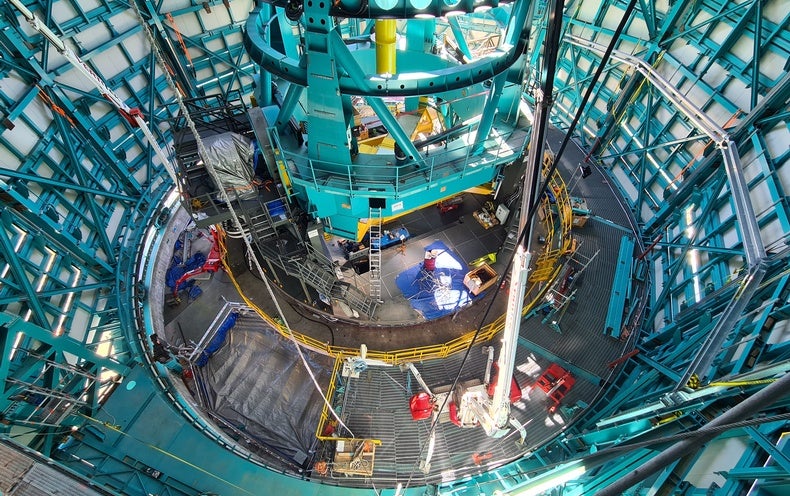Harvard’s Avi Loeb Thinks We Should Study UFOs—and He’s Not Wrong

Avi Loeb, a Harvard astrophysicist who doesn’t hesitate to swim in the shark-infested waters of controversy, is proposing a major effort to find aliens in our solar system, perhaps even in our airspace. He has raised $1.7 million in private funding to launch something he calls the Galileo Project, an initiative to bring the rigor of experimental science to ufology.
Loeb’s plan is to use a telescope now under construction, the Vera C. Rubin Observatory, to study interstellar objects that come into our solar system. In addition, the project envisions building a network of small telescopes, in groups of two, that can photograph and determine the distance to anything they see in our atmosphere.
Is this project something to be lauded, or laughed at? Although academe may dismiss the Galileo Project as nothing more than pandering to a gullible public, such prejudice is unhelpful and myopic.
Even critics acknowledge that Loeb has credentials and talent. Nonetheless, he is regarded by some in the astronomy community as a knight-errant, tilting at windmills. That’s largely because of his unorthodox views about the object ‘Oumuamua. Roughly the size of a strip mall, ‘Oumuamua was first seen as a dot on a telescope image four years ago. Its orbit tells us that it comes not from the outer reaches of our own solar system, but from somewhere else in the galaxy. While many astronomers say that ‘Oumuamua is either a comet or an asteroid, eroded and encrusted thanks to its lengthy journey through space, Loeb has suggested that it might be a chunk of alien hardware—perhaps a solar sail.
Clearly, that’s a radical hypothesis. It’s also a rebuff to Occam’s razor. The latter would caution against invoking extraterrestrial engineering when more conventional explanations suffice for understanding ‘Oumuamua.
But Loeb stands by his suggestion, and he’s recently weighed in on another puzzle, one produced by the recently released report to Congress about UAP (unidentified aerial phenomena). This study was the result of a bill passed last December instructing government intelligence agencies to put on the table all they know about UAP (also known as UFOs). In particular, the report was to address the experiences of some Navy pilots who’ve seen and photographed mysterious objects in the sky. That report, delivered in late June, said nothing about alien spacecraft (at least not in the publicly released version), but did admit that of 144 intriguing incidents, the intelligence agencies could explain only one.
So, the Galileo Project is stepping in to say “Enough already.” Let’s try and nail down such enticing phenomena with legitimate science.
The public has been whipsawed by these stories. For seven decades, the UFO believers have been belittled by serious scientists for making extraordinary claims without offering any extraordinary evidence. Now a credentialed researcher seems ready to step in to help.
That will cause some folks to roll their eyes and conclude that Loeb has gone over to the dark side. But that’s too easy. The subject is obviously important, and it should be addressed without preconceived notions or opinions based on the poor UFO evidence of the past.
But while it may be tough for Loeb to find support from his peers, those are the very people who should be grateful for his effort. The SETI (search for extraterrestrial intelligence) community, has so far failed to find either a radio or light signal from other star systems. Yes, this type of SETI experiment is getting faster all the time, and its practitioners (including myself) are hopeful that when a substantially larger number of targets has been scrutinized, an unequivocal alien signal will be found.
But an alternative SETI strategy is to search for artifacts that highly advanced societies may have constructed. That’s certainly a legitimate approach to uncovering aliens, and one that doesn’t rely on a signal reaching us just as we’re looking for it. It also takes note of the fact that the universe is three times the age of the Earth. Consequently, there should be intelligence in the galaxy at a level that is millions or billions of years beyond our own. Maybe that intelligence really does have an interest in sending hardware to other star systems.
So, it’s at least possible that we are being visited, and the Galileo Project says it will perform observations to check that out.
Still, the project is a long shot, motivated by phenomena that only a few scientists think are worthy of study. The feeling among most astronomers is that ‘Oumuamua is simply a well-traveled rock. The three tantalizing videos released by the Navy can be understood by invoking aircraft and balloons. And as for that network of telescopes put in place to record extraterrestrial hardware cruising our cluttered skies … well, the 700 orbiting satellites that already surveil our planet haven’t seen anything that humans didn’t put there.
In other words, none of the phenomena that have spurred the Galileo Project is likely to be the handiwork of aliens.
But is that good enough reason to dismiss Loeb’s exercise? In his defense, one must admit that the road less traveled occasionally leads to something interesting.
Loeb has secured private funding and has the intellectual chops to ensure the project’s scientific rigor. Anyone with lesser credentials would have difficulty getting it off the ground.
Free from the banal consideration of tenure, and with a willingness to ignore side-eye from peers, Avi Loeb is able to bet on a dark horse. As a SETI scientist, I’m grateful that he has the freedom, and the guts, to sidestep the barrier of conventional wisdom and boldly go where few would dare to go.
This is an opinion and analysis article; the views expressed by the author or authors are not necessarily those of Scientific American.


